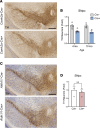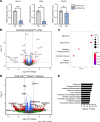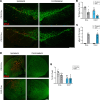Neuronal deletion of the circadian clock gene Bmal1 induces cell-autonomous dopaminergic neurodegeneration
- PMID: 38032732
- PMCID: PMC10906231
- DOI: 10.1172/jci.insight.162771
Neuronal deletion of the circadian clock gene Bmal1 induces cell-autonomous dopaminergic neurodegeneration
Abstract
Circadian rhythm dysfunction is a hallmark of Parkinson disease (PD), and diminished expression of the core clock gene Bmal1 has been described in patients with PD. BMAL1 is required for core circadian clock function but also serves nonrhythmic functions. Germline Bmal1 deletion can cause brain oxidative stress and synapse loss in mice, and it can exacerbate dopaminergic neurodegeneration in response to the toxin MPTP. Here we examined the effect of cell type-specific Bmal1 deletion on dopaminergic neuron viability in vivo. We observed that global, postnatal deletion of Bmal1 caused spontaneous loss of tyrosine hydroxylase+ (TH+) dopaminergic neurons in the substantia nigra pars compacta (SNpc). This was not replicated by light-induced disruption of behavioral circadian rhythms and was not induced by astrocyte- or microglia-specific Bmal1 deletion. However, either pan-neuronal or TH neuron-specific Bmal1 deletion caused cell-autonomous loss of TH+ neurons in the SNpc. Bmal1 deletion did not change the percentage of TH neuron loss after α-synuclein fibril injection, though Bmal1-KO mice had fewer TH neurons at baseline. Transcriptomics analysis revealed dysregulation of pathways involved in oxidative phosphorylation and Parkinson disease. These findings demonstrate a cell-autonomous role for BMAL1 in regulating dopaminergic neuronal survival and may have important implications for neuroprotection in PD.
Keywords: Aging; Neurodegeneration; Neuroscience; Parkinson disease.
Figures






References
Publication types
MeSH terms
Substances
Grants and funding
LinkOut - more resources
Full Text Sources
Medical
Molecular Biology Databases
Research Materials
Miscellaneous

